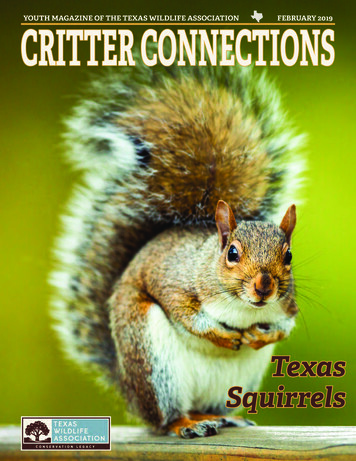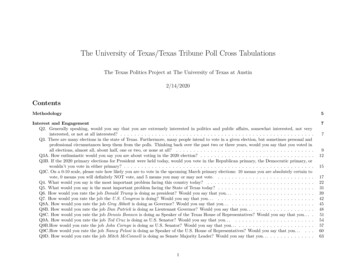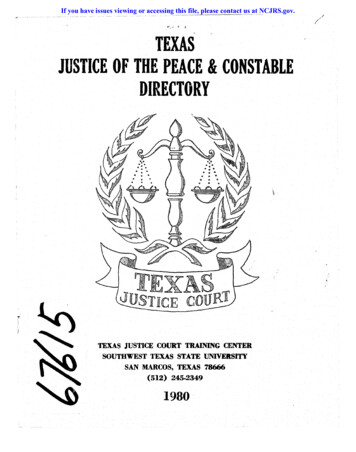
Transcription
YOUTH MAGAZINE OF THE TEXAS WILDLIFE ASSOCIATIONFEBRUARY 2019CRITTER CONNECTIONSTexasSquirrels
Texas Live OakThere are over 40 different species or types of oak tree in Texas. One of thelarger species found all over central Texas is called the Texas Live Oak, Quercusfusiformis. It has many similar features and range to the Live Oak, Quercusvirginiana. The Texas Live Oak is adapted to live in harsher conditions and is acommon tree in backyards and landscaping. It can reach heights of 20-40 feettall. They have long, wide branches with many green waxy leaves. They are anevergreen, which means they have leaves year round.Oak trees are flowering plants, but they do not produceflowers like you would normally imagine. Oak flowers,called catkins, are 2-3 inch long stems covered withmany small greenish flowers that bloom in the spring.Oak flowers are pollinated by wind, which is why theydo not need to be bright and showy like flowers thatare pollinated by animals. However this can cause problems for people allergic to oak in the springtime.Areas with many oak trees produce lots of pollen into the air which cause cold-like symptoms knows asallergies. Once the flowers are pollinated, the fruit will grow as an acorn. Texas Live Oak acorns are ¾-1inch long and are often longer than other types of acorns.Oaks are very important to wildlife. Their acorns are an important food source to many types of wildlifeincluding squirrels. The tree also provides cover and shelter for wildlife living in hollows inside the largetrunk, and birds and small mammals will build their nests up in the branches far away from predators.Photos and source: Ladybird Johnson Wildflower CenterFood Chain Mobile1. Download printable craft at: goo.gl/KDHnk32. Color and cut out the bobcat, squirrel andacorn.3. Hang or tape the acorn inside the squirrel’smouth and hang or tape the squirrel insidethe bobcat’s mouth.4. Thread a paperclip or string through the topof the bobcat’s head and hang from theceiling.2
Did you know. that a squirrel’s front teeth grow forever? that squirrels forget some of their buried nuts whichleads to new trees? that the word squirrel comes from the Greek wordskiouros, which means shadow-tailed? that squirrels can smell and recover food from underone foot of snow? that flying squirrels don’t actually fly? Instead, they glide. that squirrels build nests called dreys? that tree squirrels have very sharp claws to help climb? that baby squirrels are called kits or kittens? that squirrels will pretend to bury food to trick potentialthieves?Eastern Fox SquirrelPhoto source: M. L. HaenColor MeThirteen-Lined Ground SquirrelIctidomys tridecemlineatusImage Sheri Amsel, www.exploringnature.org33
brown back and tail.Another difference between Fox and Gray squirrels is wherethey live in Texas. Eastern Gray squirrels are found just in theEastern part of the state, but the Eastern Fox Squirrel is foundacross most of Texas, except the western panhandle region.Both are found in similar habitats, woodland areas withtrees to climb and nest. Tree squirrels and ground squirrelsare diurnal, which means they are most active and awakeduring the day.Squirrels will sleep in hollowtrees when they are available,but will also build nests to raisetheir young. A squirrel nest,known as a drey is a roundSquirrel dreyshape made of twigs and leaves,similar to a large bird nest. If you are ever in an area withmany trees, take a look at the tops of the trees and you mightsee a squirrel nest. They have long, sharp claws adapted toclimb the trees, and they use their tail to help balance whenmoving along narrow branches.Texas SquirrelsBy Elanor DeanThe squirrel family, Scuridae includes squirrels, chipmunksand prairie dogs. In Texas there are eight species or typesof squirrel including flying squirrels, ground squirrels andtree squirrels. The word squirrel comes from a Greek word,skiouros which means shadow-tailed, referring to the bushytail on certain species. Squirrels arerodents like rats, mice and beavers. Allrodents have ever-growing incisors,which means their front teeth neverstop growing. Their front teeth areorange because they are coveredwith a hard coating called enamel.Rodents must wear down their teethso they don’t keep growing into theirbrain. As they grind their teeth againsthard things such as tree bark, the softtooth underneath wears down, andthe enamel sharpens like a chisel. Thisis a trait found in all rodents.Eastern Fox SquirrelTree squirrels are mainly herbivores or plant eaters, consumingnuts, fruit, seeds and bark. They will occasionally eat insects,too. In neighborhoods, squirrels are sometimes consideredto be a pest because they will eat food from bird feeders.The most well-known foods of tree squirrels are acorns. Theylive in wooded areas where oak trees are common, so thereare many acorns for them to eat. Squirrels are well knownfor storing food for the winter in food caches. In the fall,they will dig a hole and bury the acorn underground. Theywill go back to the same spot and bury more nuts in differentlocations. Once winter comes, they are able to smell thenuts buried under a foot of snow. Sometimes, if they thinkanother squirrel, or plant eater is following them, they willpretend to bury a nut. This tricks the food thief into diggingin that same spot, only to find nothing there. While the thiefis busy searching for the nut, the squirrel is able to sneakaway to its real storage spot. Squirrels store many nuts in thefall and sometimes will not eat them all once winter comes,or will forget some of the places nuts were buried. This isvery important for the environment, because nuts that are noteaten will grow into new trees.Tree SquirrelsThere are two tree squirrels found in Texas; the EasternGray and Eastern Fox squirrels. Both of these squirrelshave similar adaptations and are what most people thinkof when imagining a squirrel. Fox squirrels are a bit largerthan the gray, measuring about 52 centimeters with their tailaccounting for almost half of that length, compared to thegray squirrel which is about 46 centimeters from head to tail.Aside from difference in size,they also have differentcolored fur. Fox squirrelsare much brighter withcinnamon-orange hair ontheir underside and tail andgrayish brown hair on theirback. Gray squirrels aremore plain in color with aEastern Gray Squirrelpale underside and grayishFlying SquirrelsFlying squirrels are also found intrees, but they are quite differentthan the other tree squirrels. Thereis one species of flying squirrel inTexas, the Eastern Flying Squirrel,and it is found in the Eastern partof the state where there are manytrees. They live in wooded habitatswith many trees to glide betweenand sites they can den. Unlike44Flying Squirrel
the other squirrels, flying squirrels are nocturnal or awakeat night. They are also quite social and will live together ingroups and communicate by making many different squeaksounds.are smaller than tree squirrels, measuring about 20-30centimeters. Their tail is not large and bushy, but is still longand covered with hair. The Mexican, Spotted and Thirteenlined Ground Squirrels have rows of spots on their back, andthe Texas Antelope Squirrel, found in desert regions in farWest Texas has two stripes down its back like a chipmunk.Flying squirrels are muchsmaller than tree squirrels,measuring only about 22centimeters long. Like treesquirrels, their tail is abouthalf of their total length. TheirFlying Squirrelcoloration is similar to thegray squirrel with a pale underside and a gray back. Theycannot actually fly, but instead will glide using a specialskin membrane known as the patagium. This membraneconnects their front and hind feet. When they spread theirlegs apart it creates a sort of parachute which allows themto glide between trees. They usually only glide 6-9 metersat a time, but have been known to glide up to 30 meters.Before jumping from a tree, the squirrel will first look aroundto determine how far it wants to go and once it is gliding itwill use its tail to steer between trees.Depending on the species, these squirrels are found in grassyor desert habitats. They use their sharp claws to dig burrowsin the ground. Sometimes they will use the abandonedburrows of other mammals. They will mainly eat plants foundin their habitat including mesquite beans, cactus, fruit, seedsand insects.Young squirrels are called kitsor kittens. When they are bornthey are blind and hairlessand rely on their mother forprotection and food. Theywill live in the burrow anddrink their mother’s milkuntil they are a few monthsSquirrel Kittenold, at which point their hairhas grown in and they are able to live on their own. In thewild, squirrels are hunted by many different predators andwill usually live for 2-5 years. Squirrels have many predatorsincluding hawks, raccoons, foxes, bobcats and snakes. Thenocturnal flying squirrels also have to watch out for owls.Squirrels are very important to the environment, both as foodfor predators and by spreading plants from seeds they bury.Flying squirrels are considered omnivores and will eatdifferent types of food including nuts, insects (both adult andlarvae), eggs, fruit and even carrion, or food that is alreadydead. They will also store nuts for the winter.Ground SquirrelsThe final and largest groupsof squirrels in Texas arethe ground squirrels. Onespecies, the Rock Squirrellooks a lot like tree squirrels,but they are found in rockyareas in central and westTexas. While they are groupedRock Squirrelwith ground squirrels, theyare able to climb trees quite well. Rock squirrels are aboutthe same size as the Eastern Gray and Fox squirrels, andthey have a large bushy tail. They are similar in color to thegray squirrel, but the front half of their back and head hasdark brown-black hair. Rock Squirrels are also omnivoresconsuming nuts, seeds, fruit, insects and sometimes evenyoung turkeys. The other four ground squirrels look more likeprairie dogs.Mexican Ground SquirrelWORD BANKIncisors – the flat front teeth of mammalsDiurnal – active during the dayDrey – a squirrel nestCache – the place where squirrels store their nuts for thewinterPatagium – a membrane of skin connecting the front andhind legs which animals like the flying squirrels uses to glideThree of the remainingground squirrels are found inCentral and West Texas andthe Thirteen-lined GroundSquirrel is in North Texas anda small strip from the DallasFort Worth area, south tothe coast. Ground squirrels Thirteen-Lined Ground SquirrelSources: The Mammals of Texas and Texas Parks and WildlifePhotos: Grendelkhan, Antoine Taveneaux, BirdPhotos.com, Palmiped, Cephas,Ken Thomas, Geoff Gallice, Greg Schechter, Travis Witt, USFWS55
Squirrel ScrambleCreated by Puzzlemaker at DiscoveryEducation.comPart 1: Clue UnscrambleUse the clues to unscramble each word or phrase and enter your answer in the boxes.A squirrel is a like a mouse, beaver or rat.TEDONRAnother name for a plant eater is .REVBERHIOTree squirrels have long to help climb trees.WLSACSquirrels have orange front that grow forever.HETTESquirrels will nuts in the ground to store them for winter.RUBYA baby squirrel is called a .KITENTFlying squirrels do not fly. Instead, they .GEILD135103412111151427689Part 2: Number PuzzleTo answer this question about squirrels, copy the letters from the numbered boxes aboveinto the boxes below with the same number. How do you catch a squirrel?1234567891011123131415Nancy’s CornerDo you know of a place nearby your home orschool where you can see squirrels?What do you think they do each day?Draw a picture of it in the blank space provided.Let’s StudySquirrels!1. Gather a journal, pencil and binoculars if needed.2. Find a spot close to where squirrels live and watch them quietly for at least 15 minutes a few times a week.3. Record what the squirrels do during the day. Describe their movement, the sounds they make and what they aredoing (climbing, building a nest, gathering food, etc.).4. Draw the squirrels in their habitat and make notes if you see an interesting behavior.5. Do this in different seasons and read back over your notes. Did you notice any changes?66
Youth Education ProgramsDiscovery Trunks* 2-week reservations* Seven wildlife topics* Hands-on materials and lessons* TEKS aligned for Grades K-8L.A.N.D.S. Program* Attend a workshop to receivenatural resource lessons* Hands-on classroom activities* Field Investigation Days* TEKS aligned for Grades 6-12Distance LearningWildlife by Design* 20-45 minute programs* Videoconferences &On-demand webinars* TEKS aligned for Grades K-8* Classroom Presentations* 30-60 minutes in length* Hands-on, inquiry-based learning* TEKS aligned for Grades K-8Educator WorkshopsTrinity River Project* Provides hands-on training andlessons for educators* Grades K-8 and grades 6-12available* 6-12 hours of CPE creditsStewarding Texas* 40 lessons about land stewardship and conservation* Available online andin every Discovery Trunk* TEKS aligned for Grades K-8* Available at no cost* Study along the Trinity River* Water quality testing and analysis* Hands-on, inquiry-based learning* TEKS aligned for Grades 4-12Critter ConnectionsTo receive a one-year subscription of Critter Connections go to-critter-connectionsCritter Connections is made possible by a grant fromthe San Antonio Livestock Exposition, Inc.Join TWA Today!www.texas-wildlife.orgTWA is a membership-based, non-profit organization whose goal is to educate all people, especially the youth of Texasabout conservation, management and stewardship of wildlife and habitat on private land.All education programs are made possible through memberships, grants and donations. Learn more about the levels ofmembership as well as the educational programs TWA offers on our website.All membership levels include a one-year subscription to the TWA monthly Texas Wildlife magazine.Membership Levels: Family 250Active 150Associate* 75Online 35* If you are an educator in the Texas please call the TWA office at 800-TEX-WILD for our educator discount.77
February 6-23, 2020
nuts, fruit, seeds and bark. They will occasionally eat insects, too. In neighborhoods, squirrels are sometimes considered to be a pest because they will eat food from bird feeders. The most well-known foods of tree squirrels are acorns. They live in wooded areas where oak trees are common, so there are many acorns for them to eat.











